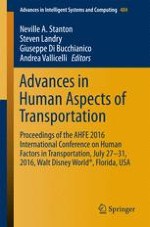2017 | OriginalPaper | Buchkapitel
Driver Distraction and Advanced Vehicle Assistive Systems (ADAS): Investigating Effects on Driver Behavior
verfasst von : David M. Cades, Caroline Crump, Benjamin D. Lester, Douglas Young
Erschienen in: Advances in Human Aspects of Transportation
Aktivieren Sie unsere intelligente Suche, um passende Fachinhalte oder Patente zu finden.
Wählen Sie Textabschnitte aus um mit Künstlicher Intelligenz passenden Patente zu finden. powered by
Markieren Sie Textabschnitte, um KI-gestützt weitere passende Inhalte zu finden. powered by
